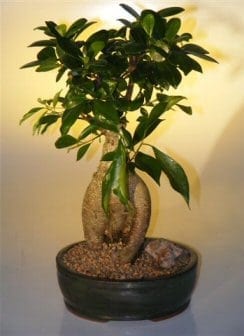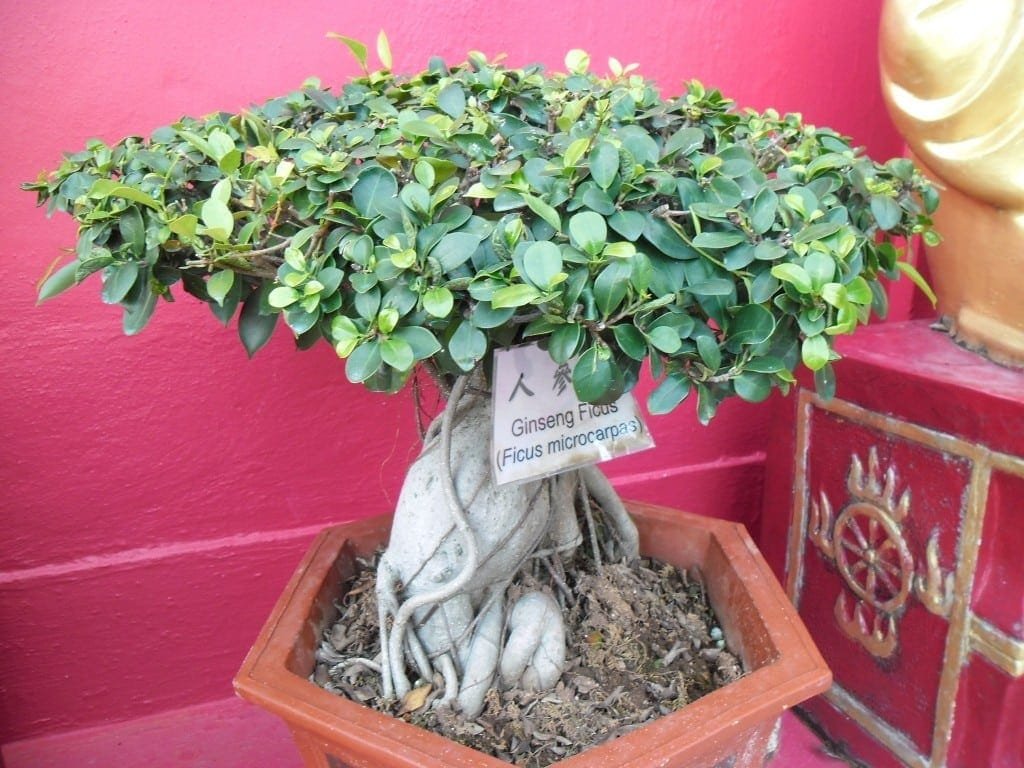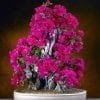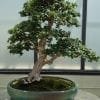Introduction
Ginseng ficus bonsai trees are very hardy and easy to take care of. Many beginning bonsai enthusiasts choose these trees to raise. They grow dense foliage, and they have very thick trunks. There are many different ficus trees, but only about six species are usually used for bonsai gardening. Ginseng ficus trees are native to Malaysia and Taiwan. These plants usually have several large roots that look like tree trunks.
Ginseng ficus trees have dark green oval shaped leaves. Their roots resemble those of other ginger trees. They have a reddish colored bark, and they can grow well with even a small amount of water. Their thick trunk makes ginseng ficus trees very hardy. While these trees all have oval leaves, their shape can vary widely.
Ginseng ficus bonsai trees or Ficus microcarpa and Ficus retusa are native in Taiwan and Malaysia. They are hardy plants with thick trunks that are easy to grow and maintain. There are a lot of bonsai enthusiasts choosing these bonsai trees to raise, growing dense foliage.
Ginseng ficus bonsai trees come in different types and about six ficus species are used in bonsai gardening, and they have large roots, that appear like trunks of trees.
The leaves of Ginseng ficus trees are oval shaped and dark green, with roots resembling ginger trees.
Their bark is usually reddish colored, and they grow very well even when the water is limited.

| Scientific/Botanical Name | Ficus retusa syn. and Ficus microcarpa |
| Description | This tropical tree is an evergreen. Its extraordinarily bulbous roots are very much like ginger roots. The thick canopy of shiny green leaves sit atop a stubby trunk. |
| Position | The tree prefers a site in full sun. When grown indoors, it should be placed on a windowsill that faces south. It is grown outdoors in tropical regions of the world. |
| Watering | Water the plant once or twice per week. It will need more frequent watering during the growing season. |
| Feeding | Feed with time-released fertilizer pellets, and provide additional liquid fertilizer during the growing season. |
| Leaf and Branch Pruning | The tree should only be pruned during the periods of active growth. The long shoots should be cut back to only a couple pairs of leaves, and this should be repeated on a regular basis while the tree grows in height. Doing so will encourage the tree to fill out. |
| Re-potting & Growing Medium | Re-pot the tree in the spring every other year with a soil mixture that comprises 60 percent aggregates and 40 percent organic matter. |
| Wiring | Setting occurs quickly once the branch has been wired. However, only the thinnest of branches can be styled with wire because thicker branches are quite stiff. |
| Notes | The fruit produced by the tree are actually inverted flowers; they are called figs. It is possible cut off the tree roots, along with the root bulge, and plant the top of the tree in soil. This eliminates the bulbous appearance of the roots. Creative use can also be made of rocks, arranging them in such a way as to make it seem as if the tree is being grown amongst rocks, and the rocks are pushing against the tree trunk. This tree gives the bonsai enthusiast a range of styling options to create interesting and aesthetic-pleasing specimens. |
In this guide, we will share helpful information about Ginseng Ficus Bonsai Trees and teach you how to effectively take care of them. We will be giving you in-depth details about these topics relating to Ginseng Ficus Bonsai.
- Growing Conditions
- Right Watering Technique
- Feeding or Fertilizing
- Leaf and Branch Pruning
- Re-potting and Growing Medium
- Wiring and Shaping Ginseng Ficus
The fruits produced by the Ginseng Ficus bonsai tree are inverted flowers which are known as figs. It’s possible to cut off their roots, along with their root bulge, and plant the topmost part of the bonsai tree in the soil, eliminating the bulbous root appearance.
The creative use of Ginseng Ficus can be made of rocks, by arranging them like growing among the rocks that push against the bonsai tree trunk, providing a wide range of styling options to bonsai enthusiasts for a more aesthetic-pleasing and interesting specimen. So let’s get started with the comprehensive guide!
1) Growing Conditions
Ginseng ficus plants can easily be grown indoors. Bonsai enthusiasts may bring their ginseng ficus trees outside, but this is not necessary. These trees are native to tropical environments, and they thrive in areas where there is lots of heat and humidity. However, they can suffer if they are put in places where the temperature falls below 15 degrees.
Ginseng ficus bonsai trees are easily grown indoors. Some bonsai enthusiasts bring their ginseng ficus bonsai trees outside.
However, this isn’t required. You have to consider the weather and climate in your area because these factors will determine whether you need to place your bonsai indoors or outdoors.
What you need is an observant assessment while doing a visual check to your bonsai trees. Here are some tips when it comes to determining the right growing condition for your ginseng ficus bonsai trees.
Tip #1: Ginseng bonsai trees thrive in tropical environments, where there is plenty of humidity and heat. However, ginseng ficus also suffers if they’re put in areas where the temperature is lower than 15 degrees.
Tip #2: Keep your ginseng ficus bonsai trees indoors so they are protected against direct sun exposure, wherein the leaves will burn if exposed to too much sunlight. They can survive in places that don’t get excessive sun exposure. It is best to keep your ginseng ficus trees near your windows facing the south. You need to ensure that you never put your ginseng ficus too close to the heat lamps. Set at least distance of a foot between the lamps and your bonsai plants. It’s best to turn the heat lamps off at nighttime.
Tip #3: Ginseng ficus appreciates staying outdoors during summer. When it comes to temperature, the most important aspect to consider is consistency. When indoors, the ginseng ficus bonsai should be kept in temperatures between 60 to 80 degrees Fahrenheit.
Tip #4: If you live in a place where the temperatures drop lower than 68 degrees, your ginseng ficus tree must be grown indoors. They should be protected from elements and drafts to avoid the occurrence of leaf drop. If they are outdoors, offer protection to your bonsai during hot summer months.
The ginseng ficus tree prefers a good site in full sun. When grown indoors, it should be placed on a windowsill that faces south. It is grown outdoors in tropical regions of the world.
Ginseng Ficus bonsai tree is low-maintenance that can be grown both indoors or outdoors. It can survive without direct exposure to sunlight. It is also a good idea placing it near an area, like a window that will receive plenty of sunlight.
2) Right Watering Technique
Ginseng ficus bonsai plants are responsive to misting. Ginseng ficus trees are perfect for novice bonsai gardeners because they are less sensitive and delicate to watering, as well as resistant to pest infestation and diseases.
Tip #1: Mist your ginseng ficus trees with good quality water from a low-pressure hose with sprinkler or spray bottle every day. The general rule is using a 1/3 of a cup of water and pouring it slowly at the base of your bonsai. Avoid overwatering by checking the bottom of the container to ensure that water is not stagnant.
Tip #2: Ginseng ficus trees are considerably more forgiving as compared to other bonsai species. They can still survive if watering is missed. These bonsai trees grow well if the compost soil is not allowed dry.
Tip #3: Ginseng ficus bonsai trees should be watered regularly when the environment is warm. You need to bear in mind that excessive water may cause the roots of the ginseng ficus to rot. If they don’t get sufficient water they will start turning yellow.
Tip #4: Ginseng ficus trees have high resistance to pests and diseases given the proper care they need.
Tip #5: Misting will only create a temporary humid atmosphere. It is important to be consistent in your misting routine. Be careful though because excess water from spraying or misting will run off the leaves of your bonsai into the soil, creating a soil structure that is continually airless and wet.
It can thrive in mild drought conditions because it stores water and soaks water through its generous roots system. Now you know how to effectively water your ginseng ficus tree using these tips, helping you with the care and maintenance of a healthy bonsai tree.
3) Feeding or Fertilizing
Bonsai fertilizers also come in liquid form, which is considered a professional plant food. The liquid fertilizer for Ginseng Ficus belongs to the latest and new generation of fertilizers. Using liquid fertilizer promotes bright and healthy green leaves, strong bud formation, stable branches, and balanced rooting. It has rapid effects and usually administered to the bonsai root systems as a foliar fertilizer.
Essential Fertilizer Elements
Your Ginseng Ficus bonsai requires three essential elements which are Nitrogen (N), Phosphorus (P), and Potassium (K). They are needed in fairly large amounts for your bonsai plant to grow and properly develop. They are listed on your bonsai fertilizer package as N:P:K ratio.
The balanced ratio would be 10:10:10, wherein a nitrogen-heavy fertilizer would have a 10:5:5 ratio. These fertilizer ratios are indicative of relative proportions, so the 10:10:10 ratio has the same mixture like 15:15:15 or 5:5:5.
- Nitrogen: This element is the first number listed on the label fertilizer ratio. It stimulates the growth of stems and leaves, giving the foliage its beautiful green color.
- Phosphorus: It is the second number listed in the fertilizer ratio in phosphate form. Phosphorus is important and responsible for a healthy growth of a bonsai root system.
- Potassium: It is the third number on the fertilizer ratio. It is usually listed as Potash, and it aids in the production of flowers and fruits, winter adaptation, and cell regeneration.
Understanding Liquid Fertilizers
Liquid fertilizers were developed by bonsai gardeners of different departments, evolving and producing based on the existing knowledge in the field of cultivation and propagation of plants.
Choose a liquid bonsai fertilizer containing the highest quality of chelates and raw materials to guarantee optimal and maximum nutrient absorption. It is a joint project of botanists and gardeners combining many years of experience and expertise in the different disciplines in horticulture.
Liquid fertilizers are the best mineral NPK fertilizers, based on the studies and latest scientific findings.
Advantages of Using Liquid Fertilizers
- Optimal nutrient absorption in the leaves and roots.
- Rapid nutrient availability via effective and complex compounds.
- Perfect nutrient combinations for various bonsai and plant species.
- Effective and rich concentrated fertilizers for faster bonsai growth and development.
- Your bonsai can benefit from the fresh and new mixtures based on the latest bonsai fertilizer standards.
- Liquid fertilizers can be well and effectively combined with pesticides.
Remember to read helpful instructions on each brand of fertilizer. Liquid fertilizers are relatively easy to use, with the dosage taking place with the help of a cap. Knowing the best fertilizer to use is crucial so you can feed your bonsai plants with ease, keeping them healthy and strong.
4) Leaf and Branch Pruning
The main reasons in leaf and branch pruning a Ficus are to inhibit its growth and enhance its shape. A typical indoor ginseng ficus tree has an exposed trunk with a very leafy crown that has a roughly rounded and bush-like shape. It can be easily trimmed and conditioned into a various configuration.
When it comes to nature, a ginseng ficus tree spreads wider with nonconforming lower limbs, owing to its less well-groomed and bushier appearance. The Ficus bonsai is shaped to exaggerate and accentuate its attractive design.
Basic Ginseng Ficus Tree Pruning
Ginseng Ficus trees should be pruned after a new growth stops in early fall and late summer. The typical ficus plant experiences this new and fresh growth during spring and early summer months. Pruning a potted ginseng ficus that is brought indoors in winter is recommended, and pruning it prior to bringing the Ficus into the house is the perfect timing.
Because a ginseng ficus tree is fairly resilient and hardy, pruning is done all year round as necessary, not just during summer or fall. Broken or dead branches are pruned any time.
When pruning a ginseng ficus tree, be prepared with a pair of reliable small pruning shears which are specifically designed for fine and close work as well as narrow stems. They should be sharp and clean for the best outcomes.
Step-by-step When Pruning Ginseng Ficus Bonsai
Step 1: Locate a bonsai node where a twig or leaves join the stem or branch.
Step 2: Before a node, cut a slight downward slant.
Step 3: Cut closer to the node without really cutting into it
Step 4: Leaving at least one bonsai node for fresh and new growth on that branch or stem is needed.
Step 5: Cut a branch to eliminate it just before the limb or trunk, not leaving any nodes
Doing so aims to create a natural-looking and well-manicured Ginseng Ficus bonsai tree.
Because of the hardiness of small leaves and rapid growth, Ginseng Ficus trees as popular evergreens. Like any other bonsai, they need frequent and methodical pruning to maintain their traditional form and desirable size. This practice requires patience and time but the results are often stunning and promising. Learn more by watching this video!
5) Re-potting and Growing Medium
The ideal time to re-pot a bonsai is highly dependent on the tree species and the area that you’re living in. For instance, a Ficus Bonsai is best re-potted during spring. Conifers are best re-potted in the late summer just before the autumn season starts.
Newly re-potted conifers recover faster when the weather is quite warm. New root growth activity is reflected in a strong flush of buds among evergreen trees coming out from a short summer dormancy.
The tools and supplies you will need when re-potting your Ginseng Ficus bonsai include the following:
- Root Shears and Root Cutters – for pruning heavy roots.
- Aluminum Wire (1.5 mm and 2 mm) – to hold the bonsai tree firmly in the container or pot.
- Wire Cutters – to prepare new wires and remove existing wire ties.
- Jin Pliers – To help in the wiring.
- Repotting Sickle – to remove the bonsai tree from the bonsai pot.
- Steel or Wood Spatula – to remove the bonsai tree out of the container.
- Soil Sieves – to strain the right size of the growing medium.
- Potting Mesh – to ensure the soil stays in the pot and keep the pests away.
- Root Hooks Single and Multiple Pronged – for untangling the root ball.
- Chopstick – to ensure that the growing medium gets in between root spaces.
- Tamping Tools – to firmly compact and flatten the growing medium in the container or pot.
- Cleaning brush or Toothbrush – used to clean the pot, and the bark.
- Camellia Oil – it gives the bonsai pot the added shine and cleans for a perfect finish.
- Turntable – serves as a potting turntable.
- Large bowl – where you place the repotted Bonsai tree for watering.
- Fine fresh moss or grated dried sphagnum moss– protects the bonsai against excessive water evaporation.
- Sturdy flat surface – need to be large enough to hold your tools and bonsai tree.
Step-by-step Guide to Re-potting
Step #1: Prepare the bonsai pot. If you’re using the same pot, remove the salt scales by cleaning the pot thoroughly using a brush. Wash then wipe to thoroughly clean the pot.
Step #2: Covering the drainage holes with square mesh is very important to control water flowing from the soil and proper water distribution on the bonsai root system.
Step #3: Wire the pot using an aluminum wire to hold it in place as you re-pot your bonsai.
Step 4: Untangle the root ball then combine out the bonsai roots. Use a single-pronged root hook to untangle the root ball, turning the root ball on the turntable while working. Move deeper until 10% of the root mass is exposed.
Lift the root ball and gently untangle any roots at the bottom of the ball.
Step #5: Using a multi-pronged root rake, comb the all the roots around the root ball. Cut the larger roots.
Step #6: Place the bonsai root-ball back into the pot, determining a suitable position for the bonsai tree in the pot. Pacing the bonsai tree to one side of the pot to emphasize the flow of the bonsai tree. There should be enough room around the bonsai root ball.
If you are expecting to prune the roots vigorously, it is best to leave it after the springtime starts so it has a better chance of healing or recovering from the trauma because the weather warms.
In addition, the sap flows freely and the new leaves produce the needed nourishment for new root development and leaf regeneration.
6) Wiring and Shaping Ginseng Ficus
Wiring is a critical step in creating or shaping a bonsai tree using wires. Many Ficus bonsai trees seem resistant to wiring and they bounce back after removing the wire. Hold the branches in position by being persistent and wiring twice or thrice as needed.
Do not remove the wire by unwinding because just a minor movement of unwinding the wire might break the new wood formed from the time the wire was applied. The newly formed wood is the only thing that holds the branch in place. Roughly unwinding the old wire can break the newly formed wood and the branch won’t hold its desired position.
Let the wire remain longer and even to permit wire “indentation” of the bonsai branch. The indentation should be minor and within a year or two, the indentation will disappear. Don’t leave the wire long because it may produce deep scars that will remain for years.
Wiring is very important to create a beautiful and appealing bonsai. Generally, it should be done with care and patience is the key to avoid frustration. By reading the guide below, you’ll learn the art of wiring and shape bonsai properly, so you can enhance your skills. Basically, you’ll need wire cutters and aluminum or copper wire for this procedure.
Step-by-step Guide to Wiring and Shaping Bonsai
Step #1: You need to stop watering your bonsai a few days prior to wiring the branches and trunk. A bonsai tree that has not been watered will develop branches that can be easy to shape without breaking.
Step #2: Wrap copper or aluminum wire surrounding the branch or trunk of the bonsai tree, starting at the base and wrapping it at an angle of 45 degrees towards the top. Use a wire that should be 1/4 to 1/3 of the trunk’s thickness. Cut the wire with the use of wire cutters when it reaches the branches’ end.
Step #3: Use a wire that is 1/3 the branches’ thickness around each branch that will be shaped. Start by wrapping the wire around the trunk once where the branch joins the trunk, then wrap the wire at 45-degree angle around the branch until it reaches the branch’ end. Do the same step for every branch that needs to be shaped.
Step #4: Determine how the branches and trunk will be shaped before shaping them. Your bonsai might be damaged if it’s reshaped too many times.
Step #5: Bending the trunk to shape your bonsai tree should be done gently and slowly. If there’s any crack or tear, stop bending right away.
Step #6: Bending every branch that you need to shape similarly the trunk should be done gently and slowly, to avoid tearing or break tor cracking the branches you want to shape.
Step #7: Cut the wire off gently or unwrap the wire after the trunk and branches have been adjusted to the desired shape. Fast-growing bonsai trees adopt the shape that was set by the wire faster than slow-growing bonsai trees. You can remove them after a month if the tree was shaped during the growing season and it grows quickly. The wire can be removed after 6 months if the tree is slow-growing or if the wiring was applied in winter.
Bonsai trees that are 3 feet tall or very big bonsai usually take twice as long to adapt to its new shape. A large and fast-growing bonsai needs at least 2 months to adapt to its new shape, and slow-growing and large bonsai require a year to adapt to its new shape.
Now that you have gained knowledge about wiring and shaping your bonsai tree, it is time to apply them and enhance your bonsai growing skills.
Final Thoughts
Ginseng Ficus bonsai trees are sturdy and resistant to pests and diseases. They are suitable for any type of gardener and the steps in caring them are pretty much the same with other types of bonsai.
Just ensure that wiring and shaping your Ficus should be gently and resistant enough to hold their branches and trunk into your desired shape because of its hard bark. Generally, Ginseng Ficus trees are the fun and challenging type of bonsai species.
Feel free to post your comment below for your insights and share your experiences for others to read. Happy Bonsai growing!


